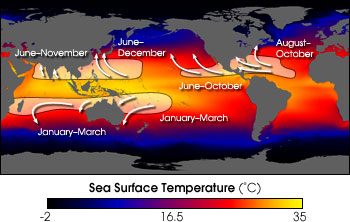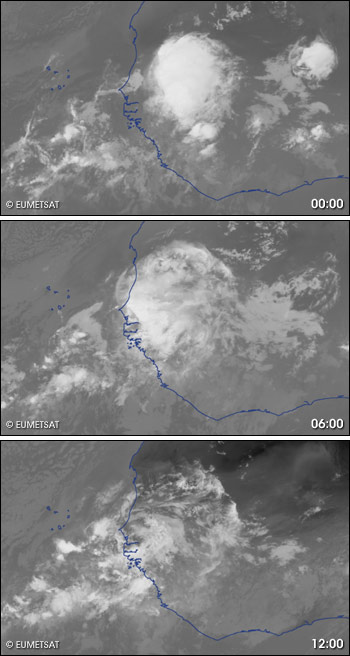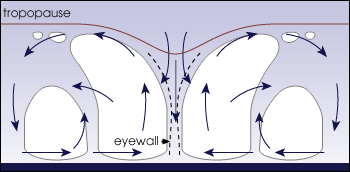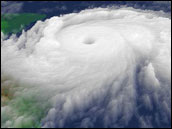

by Steve Graham and Holli Riebeek · November 1, 2006 IntroductionFew things in nature can compare to the destructive force of a hurricane. Called the greatest storm on Earth, a hurricane is capable of annihilating coastal areas with sustained winds of 155 miles per hour or higher, intense areas of rainfall, and a storm surge. In fact, during its life cycle a hurricane can expend as much energy as 10,000 nuclear bombs! The term hurricane is derived from Huracan, a god of evil recognized by the Tainos, an ancient aboriginal tribe from Central America. In other parts of the world, hurricanes are known by different names. In the western Pacific and China Sea area, hurricanes are known as typhoons, from the Cantonese tai-fung, meaning great wind. In Bangladesh, Pakistan, India, and Australia, they are known as cyclones, and finally, in the Philippines, they are known as bagyo. 
A Hurricane Katrina survivor holds snapshots of damage from Hurricane Andrew, which he took when he lived in Florida. (Image courtesy danakay/Flickr.) The scientific name for a hurricane, regardless of its location, is tropical cyclone. In general, a cyclone is a large system of spinning air that rotates around a point of low pressure. Only tropical cyclones, which have warm air at their center, become the powerful storms that are called hurricanes. Hurricane Formation and DecayHurricanes form over tropical waters (between 8 and 20 degrees latitude) in areas of high humidity, light winds, and warm sea surface temperatures [typically 26.5 degrees Celsius (80 Fahrenheit) or greater]. These conditions usually prevail in the summer and early fall months of the tropical North Atlantic and North Pacific Oceans, and for this reason, hurricane “season” in the northern hemisphere runs from June through November. 
Tropical cyclones ususally form in each hemisphere’s summer and early fall, when ocean waters are warmest. (Graphic by Robert Simmon, NASA GSFC.) The first sign of hurricane genesis (development) is the appearance of a cluster of thunderstorms over the tropical oceans, called a tropical disturbance. Tropical disturbances generally form in one of three ways, all of which involve the convergence of surface winds. When winds come together (converge), the force of the collision forces air to rise, initiating thunderstorms. Thunderstorm TriggersOne trigger for convergence is the meeting of the Northern and Southern Hemisphere easterly trade winds near the equator. The meeting of these wind belts triggers numerous, daily thunderstorms in a region called the Intertropical Convergence Zone (ITCZ). Occasionally, a cluster of thunderstorms will break away from the ITCZ and organize into a more unified storm system. Another mechanism that can lead to the formation of a hurricane is the convergence of air along the boundary between masses of warm and cold air. Along the boundary, denser cold air can help lift warm and moist air to form thunderstorms. Occasionally such boundaries, called mid-latitude frontal boundaries, drift over the Gulf of Mexico or the Atlantic Ocean off the East Coast of the United States, where developing storms can organize into hurricanes in one of two ways. Either thunderstorms organize into a large system that forms a new area of low pressure, or a pre-existing, weak, non-tropical cyclone will form along the front and will develop into a hurricane. Cyclones that form along mid-latitude frontal boundaries are often called mid-latitude or extratropical cyclones, and they typically have cold air at upper levels over the cyclone center. In contrast, hurricanes (tropical cyclones) have warm air over their centers. To change into a tropical cyclone, the cold air over an extratropical cyclone must change to warm air. This change can happen if thunderstorms occur near the cyclone center. The thunderstorms form along the frontal boundary as warm air rises over the colder air mass. As the air rises, it cools, and water vapor condenses into clouds. The heating released by condensation then helps to warm the air, and eventually the extratropical cyclone transitions into a tropical cyclone. 
Waves that occur within the dominant easterly winds over the tropical Atlantic cause areas of converging and diverging winds. The convergence forces air to rise, triggering numerous thunderstorms that can go on to become hurricanes. (Graphic by Robert Simmon, NASA GSFC.) The last and most common mechanism that triggers the development of a cyclone is the African easterly wave, an area of disturbed weather that travels from east to west across the tropical Atlantic. Essentially, an easterly wave forms because of a “kink” in the jet of air that flows west out of Africa. The jet is created by the strong temperature difference between the Sahara Desert and the Gulf of Guinea. The warm air over the Sahara rises and, several kilometers above the surface, turns southward toward the cooler air over the Gulf. The rotation of the Earth turns this air current westward to form the African Easterly Jet, which then continues out over the Atlantic Ocean. Occasionally, a “kink” will develop in the jet and move from east to west, hence the name easterly wave. Converging winds on the east side of the easterly wave trigger the development of thunderstorms, and some of these large thunderstorm systems go on to become hurricanes. Most Atlantic hurricanes can be traced to easterly waves that form over Western Africa. 
Hurricanes are commonly formed by easterly waves. The waves are “kinks” in the African Easterly Jet, a strong wind that blows over the Atlantic from the West African coast. The easterly waves trigger strong thunderstorms that move eastward. Over the warm waters of the Atlantic, the thunderstorms embedded in the easterly wave can grow into a hurricane under the right conditions. These images and animations show an easterly wave crossing the African coast during late summer 2005. The system later developed into Hurricane Irene. Cold cloud tops appear white in these thermal-infrared images, acquired by the Meteosat-8 satellite. As the easterly wave, visible as a circular area of clouds, approached the African coast it began to rotate. On August 4, the system became a tropical depression over the Atlantic. (Images copyright 2005 EUMETSAT, provided by the British Atmospheric Data Center.) Increasing OrganizationGiven favorable conditions, the tropical disturbance can become better organized into a more unified storm system. As the storm organizes, surface air pressures fall in the area around the storm and winds begin to spin in a cyclonic circulation (counter-clockwise in the Northern Hemisphere). Surface pressures fall when water vapor condenses in rising air and releases energy, or latent heat, into areas within the tropical disturbance. The heat boosts the air (increases the buoyancy), so it continues rising. To compensate for the rising air, surrounding air sinks. As this air sinks towards the surface, it is compressed by the weight of the air above it and warms. The pressure rises at the top of the layer of warming air, pushing air at the top of the layer outward. Because there is now less air in the layer, the weight of the entire layer is less, and the pressure at the ocean surface drops. The drop in pressure draws in more air at the surface, and this air converges near the center of the storm to form more clouds. 
Hurricanes intensify when condensation of water vapor in rising air releases heat energy into storm, setting off a chain reaction. The heat makes the surrounding air more buoyant, causing it to rise further. To compensate for the rising air, surrounding air sinks. The sinking air is compressed by the weight of the air above it, and it warms. The pressure rises at the top of the layer of warmed air, pushing air outward. As the air spreads outward, the total air pressure at the surface drops. The more the pressure drops, the more the winds intensify, drawing more heat and moisture from the ocean surface. (Graphic by Robert Simmon, NASA GSFC.) Like an ice skater whose body spins faster as his arms are drawn inward, air near the surface speeds up as it spirals in towards the center of the low pressure area. The increasing winds that spin around the center of the storm draw heat and moisture from the warm ocean surface, providing more fuel for the rising motions that produce the clouds and increase the temperatures. A chain reaction (or feedback mechanism) is now in progress, as the rising temperatures in the center of the storm cause surface pressures to drop even more. The lower the surface pressure, the more rapidly air flows into the storm at the surface, increasing the winds and causing more thunderstorms. More thunderstorms release more heat, forcing air at higher altitudes outward. The air pressure at the surface drops even more, triggering stronger winds, and so on. The storm takes the distinctive, spiraling hurricane shape because of the Coriolis Force, generated by the rotation of the Earth. This is the same force that causes the south-blowing African jet to bend westward over the Atlantic, spawning easterly waves. In the Northern Hemisphere, the Earth’s rotation causes moving air to veer to the right. As air rushes towards the low-pressure center of the storm at the Earth’s surface, it curves right. If the storm is far enough from the equator (generally at least 8 degrees of latitude), the deflection or curvature is great enough that the air starts spinning counterclockwise around the center of the storm. Once sustained wind speeds reach 37 kilometers (23 miles) per hour, the tropical disturbance is called a tropical depression. As winds increase to 63 kilometers (39 miles) per hour, the cyclone is called a tropical storm and receives a name, a tradition started with the use of World War II vintage code names such as Able, Baker, Charlie, etc. For a number of years beginning in 1953, female names were used exclusively until the late 1970s, when storm names began to be alternated between male and female names. Finally, when wind speeds reach 119 kilometers (74 miles) per hour, the storm is classified as a hurricane. Weakening FactorsEven when the conditions are ripe for hurricane formation at the surface, the storm may not form if the atmospheric conditions five to ten kilometers above the surface are not favorable. For example, around the area of 20 degrees latitude, the air aloft is often sinking, due to the presence of the sub-tropical high—a semi-permanent high pressure system in the subtropical regions. The high pressure pushes air towards the surface. The sinking air warms and creates a temperature inversion, an extremely stable air layer in which temperature increases with altitude, the opposite of the usual temperature profile in the lower atmosphere. Called the trade wind inversion, this warm layer is very stable, which makes it difficult for air currents to rise and form thunderstorms and (eventually) hurricanes. In addition, strong upper-level winds tend to rip apart developing thunderstorms by dispersing the latent heat and preventing the warming temperatures that lead to lower air pressure at the surface. At the surface, hurricanes can diminish rather quickly given the right conditions. These conditions include the storm moving over cooler water that can’t supply warm, moist tropical air; the storm moving over land, again cutting off the source of warm, moist air; and finally, the storm moving into an area where strong winds high in the atmosphere disperse latent heat, reducing the warm temperatures aloft and raising the surface pressure. next: Hurricane Anatomy |

Hurricane Mitch, seen here in a three-dimensional perspective, was one of the most destructive storms of the 20th century. It soaked Nicaragua and Honduras in October 1998. (Image courtesy Visual Analysis Lab, NASA GSFC.) | ||